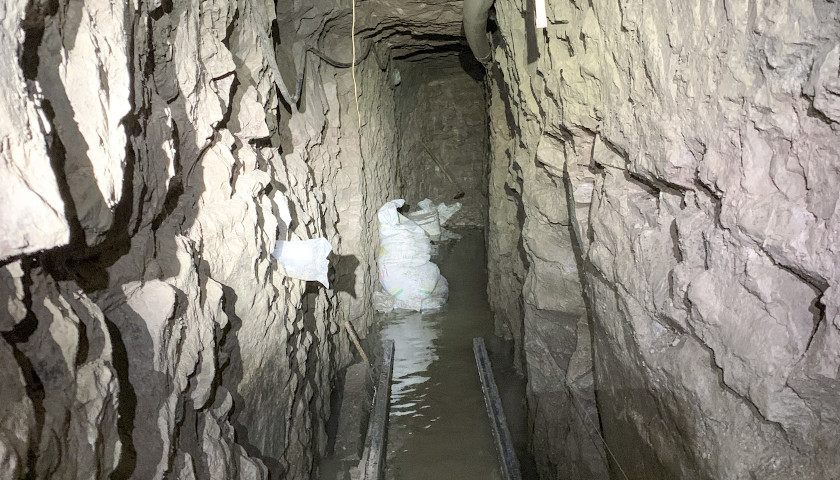by Jason Hopkins
U.S. authorities have discovered the longest smuggling tunnel ever found on the U.S.-Mexico border, with the tunnel stretching nearly a mile between Tijuana, Mexico, and San Diego.
Customs and Border Protection (CBP) announced Wednesday the discovery of an “astonishing” 4,068 feet smuggling tunnel that crosses the U.S. southern border, making it slightly more than three-quarters of a mile long. The finding smashes the record set by the now-second longest tunnel, which was uncovered in 2014 near San Diego and stretched 2,966 feet long.
 “I am thrilled that this high level narco-tunnel has been discovered and will be rendered unusable for cross-border smuggling,” Deputy Chief Patrol Agent Aaron M. Heitke said in a statement. “I am proud of the tremendous efforts of the Tunnel Task Force and our agents.”
“I am thrilled that this high level narco-tunnel has been discovered and will be rendered unusable for cross-border smuggling,” Deputy Chief Patrol Agent Aaron M. Heitke said in a statement. “I am proud of the tremendous efforts of the Tunnel Task Force and our agents.”
Mexican law enforcement first discovered the tunnel’s entrance in late August 2019 in Tijuana, near the Otay Mesa Port of Entry. The San Diego Tunnel Task Force (SDTTF) then started mapping the tunnel from Mexico. Its route travels northward into U.S. territory and then bends slightly west.
Border Patrol San Diego Sector and partners have exposed the longest illicit cross-border tunnel ever discovered along the Southwest border. Details: https://t.co/KPlEzke3ra pic.twitter.com/N8IwRxHr2H
— CBP (@CBP) January 29, 2020
The tunnel is roughly 5 1/2 feet tall and 2 feet wide, and it has an average depth of about 70 feet from the surface, according to CBP. The tunnel itself is notably sophisticated, with forced air ventilation, an intricate rail-cart system, high voltage electrical panels and cables, a drainage system, and even an elevator at the entrance of the tunnel.
“While subterranean tunnels are not a new occurrence along the California-Mexico border, the sophistication and length of this particular tunnel demonstrates the time-consuming efforts transnational criminal organizations will undertake to facilitate cross-border smuggling,” Cardell Morant, the acting special agent in charge of Homeland Security Investigations (HSI) San Diego, said in a statement.
“This discovery underscores the importance of the partnerships HSI has with the U.S. Attorney’s Office (USAO), United States Border Patrol (USBP), Drug Enforcement Administration (DEA) and other regional agencies, as collaborative investigations and community outreach are key to combating this type of threat,” Morant continued.
Additionally, authorities discovered an offshoot from the main tunnel roughly 3,529 feet into U.S. territory. While the offshoot stretched several feet, it ends without breaching the surface. What is believed to be the former exit of the tunnel was blocked with several hundred sandbags in the Otay Mesa warehouse district.
So far, no arrests or seizures have been made following the tunnel’s discovery.
“As efforts to strengthen security on our Southern Border increase, Mexican drug cartels are forced underground to smuggle their deadly drugs into the United States,” DEA Special Agent in Charge John Callery stated. “The sophistication of this tunnel demonstrates the determination and monetary resources of the cartels.”
“And although the cartels will continue to use their resources to try and breach our border, the DEA and our partners on the Tunnel Task Force will continue to use our resources to ensure they fail, that our border is secure, and that tunnels like this are shut down to stem the flow of deadly drugs entering the United States,” Callery continued.
– – –
Jason Hopkins is a reporter for the Daily Caller News Foundation.






1. Will the CDC, DHS, etc., be detaining IA border crossings to check for Contravirus?
In the press conference, the administration said they were doing Contravirus checking with international flight airline passengers, at 7 airports, but did not mention private or charter airline passengers, nor bus passengers nor walking IA crossings.
2. Press reported Russia had closed their 2600 mile border with China. If we chose to do so, could the U.S. close their 1600 mile border with Mexico or Canada? Contravirus currently is assumed to have a 14 day incubation period.